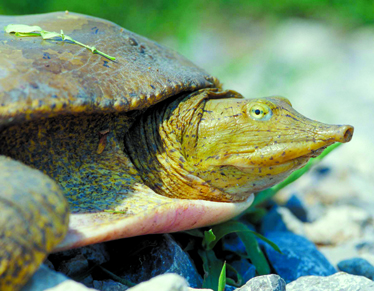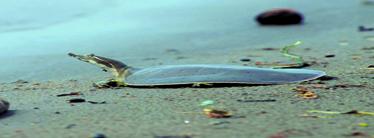Photos by Missouri Department of Conservation
Francis Skalicky, Missouri Department of Conservation 6:01 a.m. CDT July 6, 2016 (Photo: Missouri Department of Conservation)
When it comes to little-known outdoor events in Missouri, it would be safe to say few are more obscure than the state’s softshell turtle season.
If you didn’t know Missouri has a softshell turtle season that started July 1 and runs through Dec. 31, you’re probably not alone. Many people may not even know Missouri has softshell turtles. Although these large turtles reside in lakes, rivers and streams throughout most of the state, they aren’t seen as often as some of their turtle cousins.
Before we go on, let’s make it clear we’re not talking about the common snapping turtle, which is a familiar sight to Ozarkers. Common snappers are a different species from softshell turtles and can be taken throughout the year. Though they’re not classified as snapping turtles, softshell turtles are known for their biting ability — either as a means to get food or as a self-defense mechanism to avoid capture. The softshell turtles common in this area and other parts of Missouri are the Midland smooth softshell and the Eastern spiny softshell, both of which are commonly referred to as pancake turtles. Softshells aren’t seen as frequently as other turtles because they spend much time underwater, often practically buried in sandy or muddy bottoms.
The softshell turtle season is classified as a fishing season, which means you’ll need a fishing permit to take softshells. Legal methods for taking softshells include snagging, snaring, netting, pole and line, archery, trotline and throwlines (see the Wildlife Code of Missouri for details). The daily limit is five. In case you were wondering, five is also the daily limit for common snapping turtles, and you’ll need a fishing permit to take them, too.
Softshell turtles, as indicated by their name, have softer shells than other turtles found in this area. Whereas the shell of most turtle species consists of bony plates covered by hard scales called scutes, softshells have reduced bony plates covered by tough skin. The Midland smooth softshell ranges from seven to 14 inches in shell length, and the Eastern spiny is slightly larger. They feed on various types of aquatic creatures but pose no threat to gamefish populations.
 Male Midland smooth softshell turtles have an olive-gray or brown upper shell with faint markings of dots and dashes. Adult females have a mottled upper shell with blotches of gray, olive or brown. Adult male Eastern spiny softshells have an olive or grayish-tan upper shell with distinct black dots and circles and a black line along the margin. Adult females have a dark olive or tan upper shell with brown and gray blotches.
Male Midland smooth softshell turtles have an olive-gray or brown upper shell with faint markings of dots and dashes. Adult females have a mottled upper shell with blotches of gray, olive or brown. Adult male Eastern spiny softshells have an olive or grayish-tan upper shell with distinct black dots and circles and a black line along the margin. Adult females have a dark olive or tan upper shell with brown and gray blotches.
Though turtle meat may be a bit too adventuresome for some palates, a number of people who have tried it have found it to be tasty. Of course, you may never eat the meat of a softshell turtle. You might not ever see one. So why care about softshell turtles?
The answer to that question is easier than you may think. Practically all aquatic creatures are environmental indicators of some sort. Softshell turtles are slightly more pollution tolerant than some other aquatic species, but they still prefer clear water because they are sight-feeders. Also, clean water provides a greater variety of food choices, thus, clean water is what these turtles need to thrive in abundance. As long as softshell turtles continue to thrive, they will probably continue to have a season. So, as long as Missouri has a softshell turtle season, it’s a good thing. It means there is clean water for you and the turtles.
Information about softshell turtles and other types of turtles found in this state can be found in the Missouri Department of Conservation publication “Missouri’s Turtles.” This free booklet is available at the Missouri Department of Conservation’s Southwest Regional Office in Springfield. Turtle information can also be found at www.missouriconservation.org
Francis Skalicky is the media specialist for the Missouri Department of Conservation’s Southwest Region. For more information about conservation issues, call 417-895-6880.



Facebook Comments